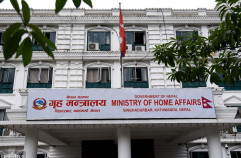A marine bird has survived in Nepal

We use Google Cloud Translation Services. Google requires we provide the following disclaimer relating to use of this service:
This service may contain translations powered by Google. Google disclaims all warranties related to the translations, expressed or implied, including any warranties of accuracy, reliability, and any implied warranties of merchantability, fitness for a particular purpose, and noninfringement.

Highlights
- According to senior ornithologist Hemsagar Baral, a bird found in the seas, rivers and wetlands of Europe, Asia, Africa and Australia has hatched a baby for the first time in Nepal.



The sea bird Thimaha falfalyle has hatched in Jagdishpur Lake, a bird sanctuary in Kapilvastu. Pictures of 5 bachera in two places in the north-eastern corner of the mound in the middle of Jagdishpur Panchhi Reserve. Dr. Janakpur. Filmed by SK Singh.

Dr. Singh took pictures of 3 cubs in one well and 2 cubs in the other. "While going to the boat, the falcon hit the head like a thong," he said. A doctor by profession, he says that his hobby is wildlife photography. Anil Chaudhary, the nature cow, said that he saw 60/70 moths fly and stay in the Jagdishpur lake area. According to him, there are at least 15 nests.
Himsagar Baral, a senior ornithologist, said that the bird found in seas, rivers and wetlands of Europe, Asia, Africa and Australia has hatched a baby for the first time in Nepal. "It is good for the country, it has increased the attraction towards tourism," he said. Photographers Sugam Tamrakar and Pemba Sherpa in Jagdishpur in the second week of August last year and Nisan Baral at Koshi bridge found the nest of Thimaha falcon. But after the news that Thimaha Falafya was perched on Otharo came out, the crowd of people taking pictures increased in Jagdishpur and the bird left Otharo and ran away. In Koshi, Baral could not do 'nesting follow-up'. This year, Deepak Bahadur Gurung, Ward President of Kapilvastu Municipality-9 said that it is strictly necessary to go into the lake so that the seabirds can grow well.
 As an irregular winter visitor and a common species in the spring, the winter falcon is a bird. Although there is no research on where this bird comes from in Nepal, ornithologists say that it can be assumed that it comes from around the Arabian Sea. This bird, which is more common in other countries, is rarely seen in Nepal. Due to its very sharp beak, it is difficult to photograph this bird at any time other than when it is nesting. This bird roosts in water with weeds and grasses on leaves. There are 8 species of falafel. Thimaha Falfale eats the insect Phatangra. This bird, which lives in July, hatches its young in three weeks and raises them in two/three months.
As an irregular winter visitor and a common species in the spring, the winter falcon is a bird. Although there is no research on where this bird comes from in Nepal, ornithologists say that it can be assumed that it comes from around the Arabian Sea. This bird, which is more common in other countries, is rarely seen in Nepal. Due to its very sharp beak, it is difficult to photograph this bird at any time other than when it is nesting. This bird roosts in water with weeds and grasses on leaves. There are 8 species of falafel. Thimaha Falfale eats the insect Phatangra. This bird, which lives in July, hatches its young in three weeks and raises them in two/three months.
In 1982, this bird was seen in the number of more than 400 in Koshi Barrage. Ornithologist Hathan Chaudhary said that this bird was seen for the first time in Jagdishpur last year after 41 years. He said that when the temperature of the sea increases due to the effect of climate change, such birds may have chosen Taltalaiya and wetland areas to raise their young. After the bird reserve, the biological diversity of Jagdishpur lake has been protected. Therefore, new birds have chosen to build nests and rear their young,' said ornithologist Krishna Prasad Bhusal.
Jagdishpur Lake has been sheltering the most waterfowl in Nepal. According to a study conducted by IUCN Nepal, 43 species of fish, 10 species of amphibians, 42 species of reptiles and 32 species of mammals are found in this area. 167 species of birds are found in the lake area, 92 species of raithane,
The study showed that 9 species of birds come in summer, 64 species of birds come in winter and 3 species of birds are partial migrants. The world's rarest wild animal water cat and 8 species of birds are also found here.
 प्रकाशित : भाद्र ३०, २०८१ ०५:५९
प्रकाशित : भाद्र ३०, २०८१ ०५:५९

 २८.१२°C काठमाडौं
२८.१२°C काठमाडौं














